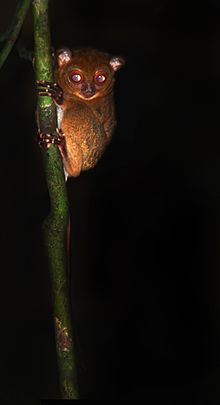Western tarsier
| Horsfield's tarsier | |
|---|---|
 |
|
| Cephalopachus bancanus | |
| Scientific classification | |
| Kingdom: | Animalia |
| Phylum: | Chordata |
| Class: | Mammalia |
| Order: | Primates |
| Family: | Tarsiidae |
| Genus: |
Cephalopachus Swainson, 1835 |
| Species: | C. bancanus |
| Binomial name | |
|
Cephalopachus bancanus (Horsfield), 1821 |
|
 |
|
| Horsfield's tarsier range | |
Horsfield's tarsier (Cephalopachus bancanus), also known as the western tarsier, is the only species of tarsier in the genus Cephalopachus. It occurs on Borneo, Sumatra and nearby islands and is, like other members of the group, entirely nocturnal.
Although Horsfield's tarsier was usually placed in the genus Tarsius with all other living tarsiers, it is quite distinct from the Philippine tarsier and the various tarsiers of Sulawesi and nearby islands; therefore, scientists have placed it in a separate genus, Cephalopachus.
The taxonomy of this species is in doubt, with some subspecies considered unsure. In fact, over 20 years few studies have been done on C. bancanus and a taxonomic revision based upon intensive and systematic field surveys is overdue. The IUCN believes that these subspecies should be treated as distinct and named as separate taxa until more definitive evidence is available. When splitting the species into its own genus, Colin Groves and Myron Shekelle recognized the natunensis population as a distinct subspecies.
There are four recognized subspecies of Horfield's tarsier:
The pelage coloration ranges from pale-olive or reddish brown to pale or dark grey-brown, possibly varying with age. Based on 12 collected specimens, the range measurement from head to body is 121–154 mm. Horsfield's tarsier has an extremely long tail which can reach 181 to 224 mm and is hairless except for tufts of hair at the end. This species has two grooming claws on each foot. The fingers are very long and have pads on the tips. The toes have flattened nailes except for the second and third toes on hind feet, which bear claw-like nails. It has large eyes which do not reflect light. The membranous ears are slender and almost bare. The molars of this species have high-cusps and are almost tritubercular. The dental formula of Horsfield's tarsier is 2:1:3:3 on the upper jaw and 1:1:3:3 on the lower jaw.
Horsfield's tarsier is found in Southern Sumatra, Borneo and nearby islands. The Bornean subspecies, C. b. borneanus, is known from many lowland sites in Sabah, Brunei, Sarawak and West Kalimantan and above 900m in the Kelabit uplands in Northern Sarawak. Other records show it from Kutai and Peleben in East Kalimantan and Tanjung Maruwe in Central Kalimantan. This species can live in both primary and secondary forests, and it also lives in forests along the coasts or on the edge of plantations.
...
Wikipedia

